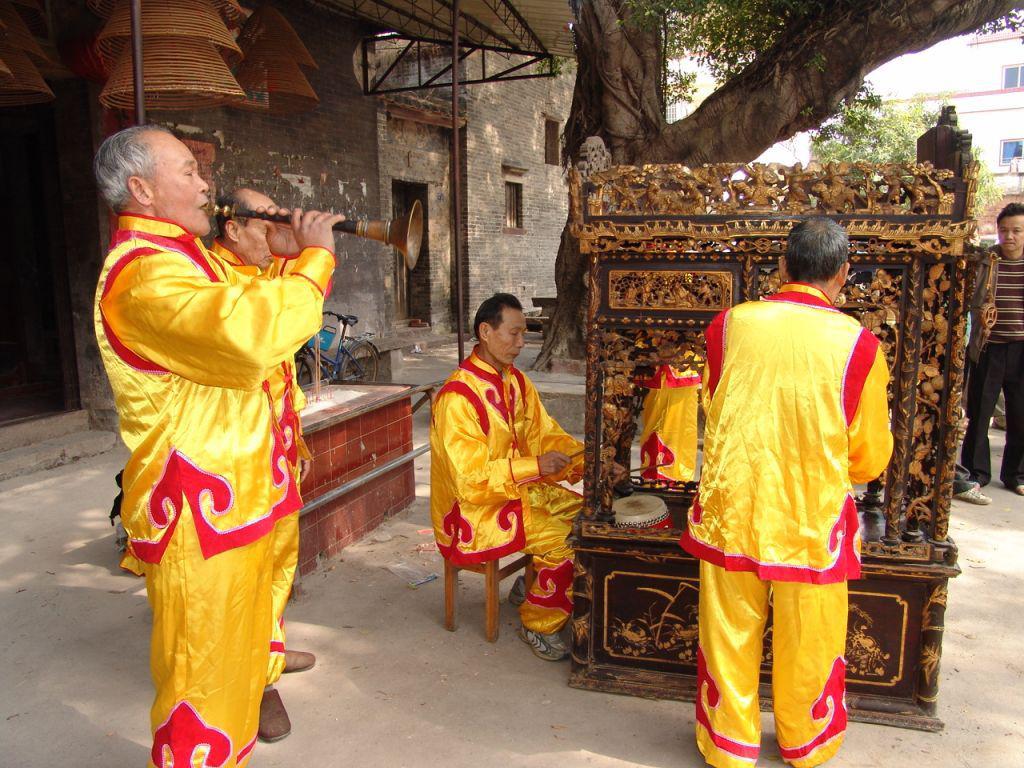Foshan National Intangible Cultural Heritage Gong and Drum Art - Eight-tone Gong and Drum
Eight-tone gongs and drums are folk music that includes three performance forms: wind and percussion music, eight-tone singing, and gongs and drums.
Wind and percussion music is a festive and ceremonial music performed in folk festivals, competitions, funerals, fasting and official activities, etc. Eight-tone singing is performed by eight-tone artists while singing a complete set of operas. It is called opening octave, and Shunde is called Xiqin; the gong and drum cabinets use large and small suonas to imitate Shengdan singing to play a complete set of operas. Because a wooden cabinet with gorgeous decoration and a rectangular pavilion with eaves and no lids must be prepared to place percussion instruments, so named. Wind and percussion music, gongs and drum cabinets are the predecessors of Cantonese music, and singing octaves is the originator of Cantonese opera. Before the founding of the People's Republic of China, eight-tone gongs and drums spread all over Foshan.
During the period of the Republic of China, Cantonese opera and Cantonese opera were popular, and singing in the Western Qin Dynasty gradually declined. After the founding of the People's Republic of China, the practice of changing customs and practices, traditional wind and percussion music was not advocated at weddings and funerals, and only rural areas that were relatively weak from the impact of modern civilization retained the form of gongs and drums. The Eight-Yin Gong and Drum Organization (also known as the Gong and Drum Association) has an elegant name, such as "Shengping Yazong", "Geng Yu Xiaoyong" and so on. Since 1984, Shunde Xingtan "Mingsheng Tongtai", "Xihuazhuang", "Heleqiong Building", "Cloud Gate Xiaoxie", "Yasongsheng Building", "Taiping Villa", "Xiyi Homologous", "Lianqing" Nine eight-tone gongs and drums organized in Yaju ""Tao Qing Ya Yong" have resumed their activities successively, and 7 wooden cabinets of gongs and drums with a history of more than 100 years have participated in performances in large-scale events for many times.
Eight-tone gongs and drums are divided into three categories: percussion, blowing, and pulling. The types of percussion include sand drums (or sandy ones), bu fish, war drums (or two-sided flat drums), big cymbals, high side gongs, big text gongs, singles, gongs (Jingxiao gongs) and so on. There are big suona, small suona, horizontal flute, short throat and long throat. There are two-stringed, bamboo violin, Yueqin, three-stringed and other hard bowed instruments. Later, common instruments in modern Cantonese opera, such as Yehu, Qinqin, Bianzu, and saxophone, were introduced. Eight-tone gongs and drums use large and small suonas to imitate Shengdan's singing to perform a complete set of operas, accompanied by silk and bamboo instruments, and also play brand music and minor tunes. The complete sets of operas include "The Great Prime Minister of the Six Kingdoms", "The Immortal Fairy Sends His Son", "Eight Immortals Congratulates His Birthday", "Bai Li Xi Meets His Wife", "Guan Gong Sends His Sister-in-law", "Benevolence Returns Home" and so on. Later, they also performed popular stage plays, such as "The Old Man Entering the Flower Bush", etc. Some gong and drum clubs also introduced the play (puppet show) in the big house, and brand songs such as "Deng Dian", "Spring Comes", "Six Waves Order" and "The Big Door" "The Order of Victory", minor tunes such as "Hundred Flowers Pavilion", "Flowers Tune", "Up the Cloud Ladder", etc., are characterized by retaining the style of ancient Cantonese opera, such as the imitation of the singing tune in stage Mandarin, using big gongs and drums and rigid musical instruments ( Also known as hard bow), simple, rough and warm. With the development of the times, Cantonese music is also played, and the instruments commonly used in modern Cantonese opera are added.

Eight-tone gong and drum performance. (Source: Foshan Intangible Cultural Heritage Protection Center)
The eight-tone gong and drum cabinet is dependent on folk customs, and will surely lead to the excavation and utilization of various valuable folk custom activities. Eight-tone gongs and drums are inextricably linked with Cantonese opera, Cantonese opera, and Cantonese music, and have irreplaceable value for academic research on the three. Protecting and inheriting the eight-tone gongs and drums has far-reaching significance in promoting the development of Cantonese opera, Cantonese opera and Cantonese music.
 渝公网安备 50010702504639号
渝公网安备 50010702504639号